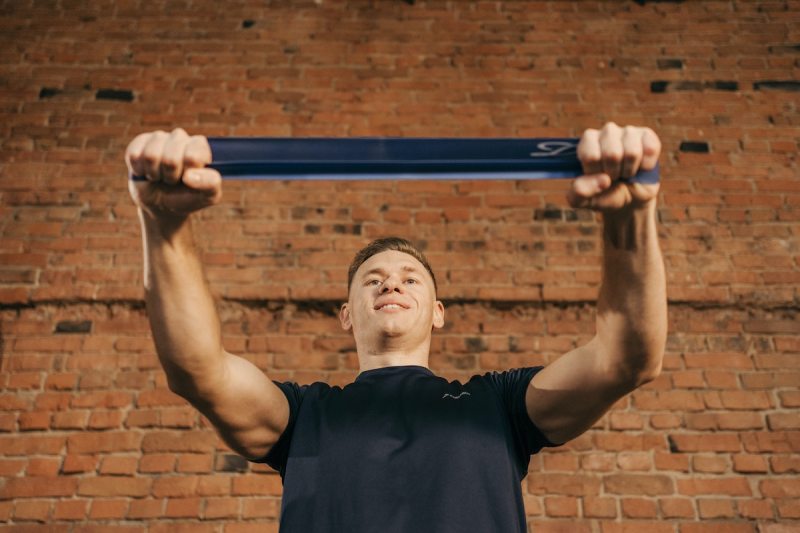
Many people seek to get stronger and more able through their strength training workouts, but they may wonder how to build muscle to improve their physique and bulk up. A great method for adding on mass is through hypertrophy training, which is a form of training achieved by using heavier weights during high-volume training.
Although a lot of people assume that you can only build muscle by lifting dumbbells, barbells, or other traditional weighted implements, it’s possible to do so with resistance bands as well. Resistance bands provide a low-cost, portable, and convenient way to do at-home strength training workouts for those who can’t afford a gym membership or prefer the convenience, efficiency, and privacy of working out at home.
To learn more about how to build muscle using resistance bands instead of weights, we spoke to Seamus Sullivan, a certified strength and conditioning coach and a certified Precision Nutrition professional who has been training clients for over seven years.
Keep reading to learn expert tips on how to build muscle using resistance bands and increase your gains even if you don’t have access to weights.
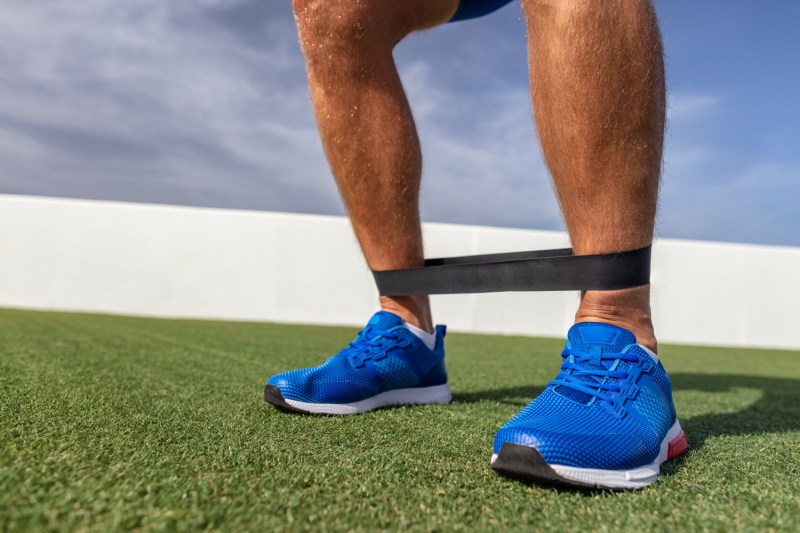
How does muscle growth occur?
Ultimately, muscle building is the process of hypertrophy. Hypertrophy occurs in a two-step process in which you first break down muscle fibers through high-intensity training (typically resistance training workouts). Then, as long as your body has a sufficient supply of amino acids from dietary protein and adequate caloric intake to support muscle repair, the process of muscle protein synthesis will help prepare and rebuild your muscle fibers to be stronger and larger.
“The usual factors for hypertrophy are mechanical tension, muscle damage, and metabolic stress,” Sullivan said. “Mechanical tension is when a load is placed upon a muscle while the muscle goes through a full range of motion. This leads to muscle damage that, with rest, will now allow the muscles to grow. Lastly, metabolic stress creates signals which have similar effects to mechanical tension to initiate hypertrophy.”
Sullivan also noted that to promote hypertrophy, resistance training exercises need to be performed in sets close to failure.

How much muscle can you gain?
People often have unrealistic expectations when it comes to gaining muscle. Impacting factors like genetics and age are out of your control, but you can optimize your training regimen, eating habits, sleep routine, and rest and recovery to get results as efficiently as possible.
If you are diligent, then you will likely gain between 0.5 and two pounds of muscle per month. Patience is key, and it is important to take progress pictures and measurements to help you stay on track with your gains.
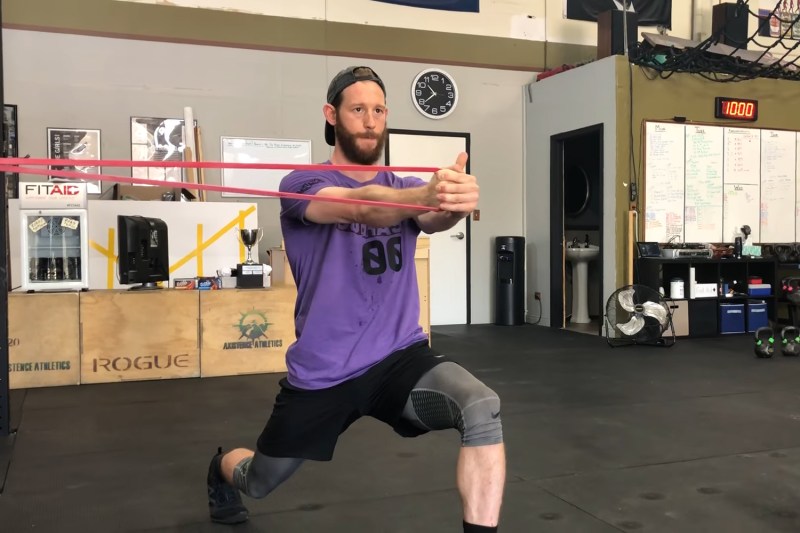
Can you build muscle with resistance bands?
Sullivan told us that despite the prevailing theory that you have to lift weights or use machines to build muscle, you can absolutely build muscle with resistance bands.
“Resistance upon a muscle can be done in many ways, and bands are a great way to do it,” he said. “The difference between bands and free weights is the resistance curve. A free weight will stay the same amount of weight throughout a range of motion. However, with a band, it gets hard as you stretch it more,” he explained. “For example, a bicep curl on free weights will have the tension of the weight primarily in the middle range of the movement. For the band, the tension will still be there in the middle, but then towards the top range, it will be even more difficult, as the band is now stretched out even more. This can be beneficial for muscle and strength gains. Anything that takes the muscle close to failure will allow for hypertrophy.”
Essentially, Sullivan said that you do not have to use dumbbells, barbells, or weights in order to “train your muscles to failure.” You can support muscle growth with resistance band workouts as long as you are trying to replicate an equally challenging load that properly taxes your muscles and performing enough training volume to support muscle growth.
He suggested individuals structure their workouts by starting with exercises that target larger muscle groups and then working their way down toward smaller muscle groups.
“For bigger muscle groups, you can load with heavier resistance, with three to four sets between six to eight reps. Then, go into smaller muscle groups at three to four sets with eight to 12, even 12 to 15 reps,” he advised. “All these can work only if someone takes their exercises close to failure. In terms of frequency, it is recommended to work a muscle group two times per week for adequate muscle growth.”

Sample resistance band workout for muscle growth
Sullivan provides an example of an upper-body resistance band workout for building muscle:
- Resistance band chest presses: 3 sets of 4 to 6 reps at max effort
- Resistance band seated rows: 3 sets of 8 to 12 reps with a resistance that takes you to failure by the end of the set
- Resistance band lateral raises: 4 sets of 12 to 15 reps
- Resistance band bicep curls: 3 sets of 12 to 15 reps
- Resistance band tricep extensions: 3 sets of 12 to 15 reps at a resistance that takes you to failure by the end of the set
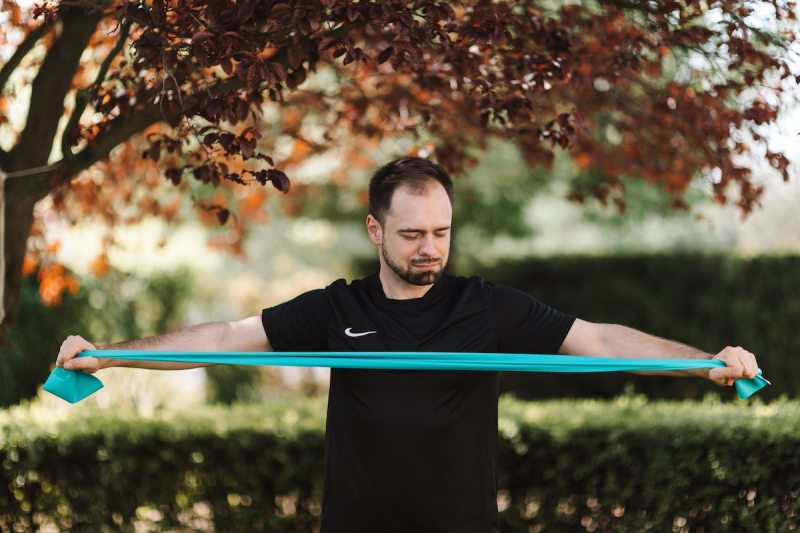
How long does it take to build muscle using resistance bands?
The amount of time it takes to build muscle using resistance bands depends on a number of factors, including your starting fitness level, your diet, and your training routine. However, most people can expect to see noticeable results within 4 to 8 weeks of regular training.
Here are some tips for maximizing your muscle gains with resistance bands:
- Focus on compound exercises that work multiple muscle groups at the same time.
- Increase the resistance of your bands as you get stronger.
- Aim for 2 to 3 sets of 8 to 15 repetitions of each exercise.
- Rest for 1 to 2 minutes between sets.
- Train 2 to 3 times per week.
- Eat a healthy diet that includes plenty of protein.
- Get enough sleep.
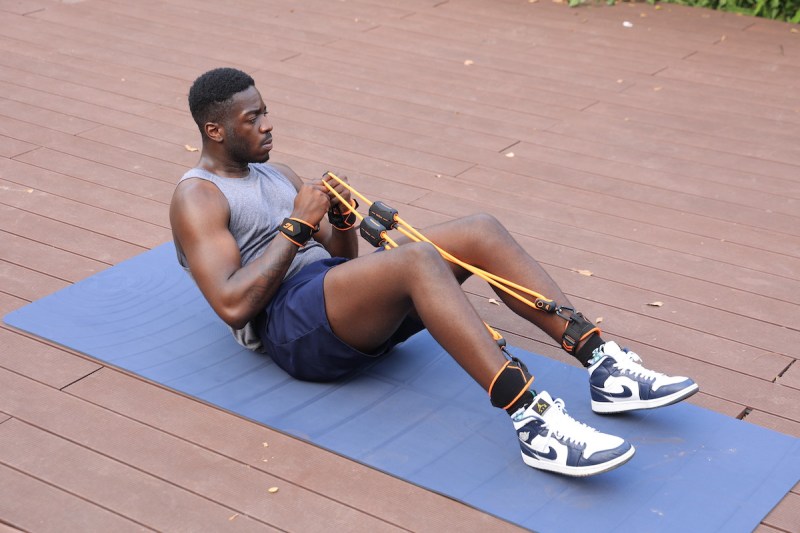
How to assess your workload with resistance bands
One of the challenges of using resistance bands is that it can be difficult to know exactly how much you’re lifting. “Some bands have instructions … that color-code which bands are easier [or] harder. Some of these bands or instructions note the load the band is trying to mimic,” Sullivan said. “It is actually hard to know the exact weight, so you often have to go off of ‘feel’ and reps, then note which band was used for the next workout.”
For serious weightlifters looking for a more exact and scientific approach, the good news is that there are now a few innovative smart resistance band training systems that actually can tell you your effective lifting load. Some even allow you to set your desired resistance with the band for more precise training. The two best options are the LIT AXIS™ smart resistance bands and We Gym. Both systems employ smart technology with built-in sensors that allow you to track not only your reps and sets, but also how much resistance load you are using and your time under tension.
The LIT AXIS system can even analyze each axis of movement, detect and correct muscle imbalances on the left and right sides of the body, and use that data to predict and prevent injuries. You can dial-in specific resistance loads you want to use up to 200 pounds, much like using traditional weights. Yet, you still have the convenience, portability, and functionality of traditional resistance bands.
Similarly, with We Gym, you can adjust the exact resistance you want to use from 10 to 110 pounds. You can also view your workout metrics in real-time, giving you just as much control and precision over your resistance band workouts — if not more so — than when doing traditional weightlifting with clearly labeled weights. The system allows you to have more control over your progress and training to best support your muscle gains and hypertrophy goals.



